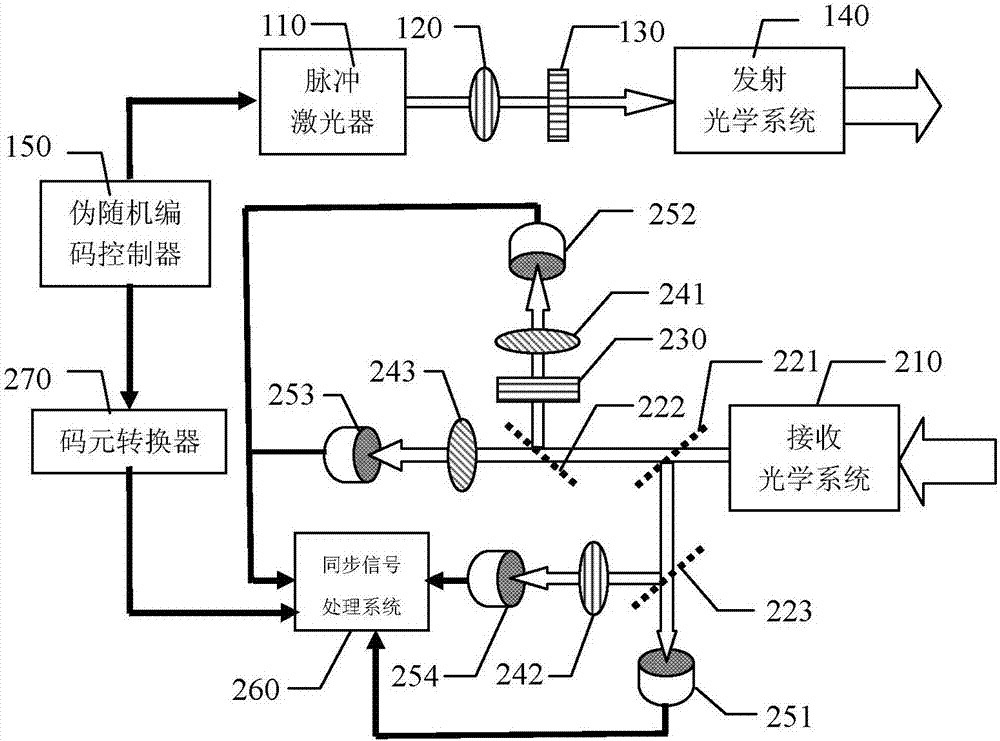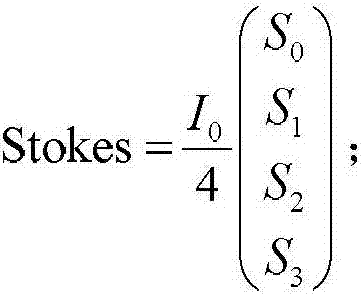Extremely-weak optical signal degree of polarization detection system and detection method based on same system
A detection system and polarization degree technology, applied in the field of extremely distant target detection and identification, can solve problems such as single information, and achieve the effect of breaking through the counting bottleneck
- Summary
- Abstract
- Description
- Claims
- Application Information
AI Technical Summary
Problems solved by technology
Method used
Image
Examples
specific Embodiment approach 1
[0064] Specific implementation mode one: refer to figure 1 Describe this implementation mode in detail. A very weak optical signal polarization detection system described in this implementation mode includes: a transmitting unit and a receiving unit;
[0065] The transmitting part includes: a pulsed laser 110, a polarizer 120 of the transmitting part, a 1 / 4 wave plate 130 of the transmitting part, a transmitting optical system 140 and a pseudo-random code controller 150,
[0066] The code sequence signal output terminal of the pseudo-random code controller 150 is connected to the code sequence signal input terminal of the pulse laser 110, and the pulsed laser light emitted by the pulse laser 110 is transmitted to the transmitter through the polarizer 120 of the transmitting part and the 1 / 4 wave plate 130 of the transmitting part in sequence. The optical system 140, the transmitting optical system 140 collimates and expands the incident light and emits it to the target to be d...
specific Embodiment approach 2
[0074] Specific embodiment 2: This embodiment is a further description of a very weak optical signal polarization detection system described in specific embodiment 1. In this embodiment, the polarizing angle of the second polarizer 242 of the receiving part is 90° °, the polarizing angles of the No. 1 polarizer 241 and the No. 3 polarizer 243 of the receiving part are both 45°, and the azimuth angle of the 1 / 4 wave plate 230 of the receiving part is 0°.
specific Embodiment approach 3
[0075] Specific embodiment three: This embodiment is a further description of a very weak optical signal polarization detection system described in specific embodiment two. In this embodiment, the synchronous signal processing system 260 includes the following units:
[0076] Stokes parameter setting unit:
[0077] Let the Stokes parameter of the echo signal light collected by the receiving optical system 210 be:
[0078] (S 0 S 1 S 2 S 3 ) T
[0079] Among them, S 0 , S 1 , S 2 , S 3 are the four parameters of the normalized Stokes parameter,
[0080] Because the echo signal light is divided into four paths by No. 1 optical splitter 221, No. 2 optical splitter 222 and No. 3 optical splitter 223, the total intensity of setting the echo signal light signal is 1 0 , then the intensity Stokes of each echo signal light Stokes parameter is:
[0081]
[0082] The corresponding light intensity acquisition unit of the detector:
[0083] The Stokes parameter Stokes1 ...
PUM
 Login to View More
Login to View More Abstract
Description
Claims
Application Information
 Login to View More
Login to View More - R&D
- Intellectual Property
- Life Sciences
- Materials
- Tech Scout
- Unparalleled Data Quality
- Higher Quality Content
- 60% Fewer Hallucinations
Browse by: Latest US Patents, China's latest patents, Technical Efficacy Thesaurus, Application Domain, Technology Topic, Popular Technical Reports.
© 2025 PatSnap. All rights reserved.Legal|Privacy policy|Modern Slavery Act Transparency Statement|Sitemap|About US| Contact US: help@patsnap.com



